Published: 9 April 2019
Demand for accommodation services grew by 1.5 per cent in 2018
In 2018, accommodation establishments in Finland recorded over 22 million overnight stays, of which domestic tourists accounted for around 15.4 million and foreign tourists for good 6.8 million. The foreign and domestic demand for accommodation services grew both by 1.5 per cent from the previous year. The total demand for accommodation services grew equally much, or in total by 1.5 per cent in 2018.
The demand for accommodation services turned to growth starting from 2016 and still grew strongly in 2017. Last year, the growth in demand for accommodation services continued moderately in every month of 2018 except for July and September, when demand went down by one per cent in both. The biggest growth percentages came in the early part of the year, when demand grew in January to February by around four per cent in both and in March, when the growth was five per cent compared to 2017. In October and December the growth was approximately three per cent and in November around two per cent. In other months demand for accommodation services grew by one per cent or remained on level with 2017. These figures are data from Statistics Finland’s statistics on accommodation establishments and they have been collected from accommodation establishments with at least 20 beds or caravan pitches with electricity connection.
Year-on-year changes in nights spent (%) by month 2018/2017
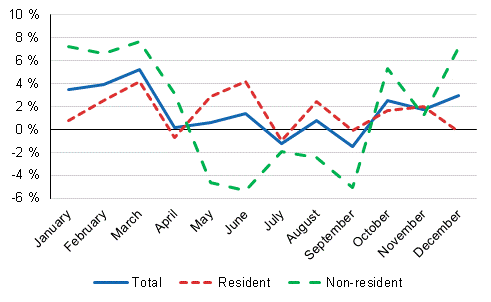
Russians still formed the largest group of foreign visitors in accommodation establishments in 2018
Russians were still the largest group of foreign tourists in Finnish accommodation establishments in 2018. A total of 826,000 overnight stays were recorded for them, which was nearly one per cent more than in the year before. The share of Russians among all overnight stays by foreign tourists remained at 12 per cent in 2018 just like in 2017. Germans came second with good 628,000 overnight stays. Their overnight stays increased by 0.9 per cent year-on-year. British tourists rose to the third biggest group surpassing Swedes with their 593,000 overnight stays. The number was 1.2 per cent higher than in 2017. British visitors were followed by Swedes whose number of overnight stays at accommodation establishments was 560,000. However, overnight stays by Swedish tourists decreased by 6.2 per cent compared with 2017.
Nearly 333,000 overnight stays were recorded for Chinese tourists, which made them the fifth largest group after Swedes. Overnight stays recorded for French visitors increased by 6.9 per cent and totalled good 299,000 at accommodation establishments. Among the most important countries of inbound tourism to Finland, the biggest growth percentages came from the United States, the Netherlands and Spain. Visitors from the United States spent 7.5 per cent more nights in Finland and their overnight stays amounted to almost 289,000. Overnight stays by Dutch tourists increased by 8.4 per cent and they amounted to good 246,000. The number of overnight stays by Spanish visitors was 8.3 per cent up on the previous year, but their stays remained at 176,000 nights. Estonian tourists reached nearly 222,000 overnight stays and Japanese visitors slightly under 216,000. Overnight stays by tourists from Estonia increased by 1.3 per cent while those by Japanese tourists decreased by 9.5 per cent.
Examined by continent, Asia exceeded the one million mark for overnight stays for the first time in 2017. Last year did not differ from the previous year, because Finnish accommodation establishments recorded slightly under 1.1 million overnight stays for Asians. Overnight stays by Chinese and Japanese visitors covered 51 per cent of all overnightings of the whole Asia. Overnight stays by Japanese tourists diminished throughout last year, which partly had an effect on that overnight stays by visitors from Asian countries went up by just 1.7 per cent in 2018. Nearly 878,000 overnight stays were recorded for the Nordic countries, which was 5.6 per cent down on the year before. Examined by continent, the biggest growth percentage came from Oceania, 13.0 per cent and good 100,000 overnight stays. In all, 0.8 per cent more overnight stays were recorded for visitors from EU countries than in 2017, the number of nights rising to 3.6 million. Tourism from America increased by 6.0 per cent and overnight stays amounted to good 401,000. Overnight stays recorded for African visitors numbered nearly 31,000 in 2018, which was 9.1 per cent more than in 2017.
Change in overnight stays 2018 / 2017, %
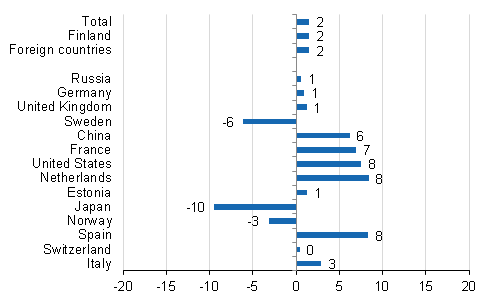
Number of nights spent at hotels totalled good 17.7 million in 2018
In 2018, the total number of nights spent in hotels was good 17.7 million, which was 1.4 per cent higher than in 2017. In total, 12 million overnight stays were recorded for resident tourists and around 5.7 million for non-resident tourists. The overnight stays of resident visitors increased by 1.5 per cent and those of non-resident visitors by one per cent from 2017. Overnight stays at hotels covered almost 80 per cent of all overnight stays at accommodation establishments. The share of foreign tourists of overnight stays in hotels was 32 per cent and 31 per cent of all overnight stays at accommodation establishments.
The occupancy rate of hotel rooms for the whole country was 55.4 per cent in 2018. One year earlier it was 55.9 per cent. The average price of a hotel room has been growing since 2011, when the average price was EUR 88. In 2018, the average price of a hotel room was EUR 104.
Hotel room occupancy rate and the monthly average price in 2017 and 2018
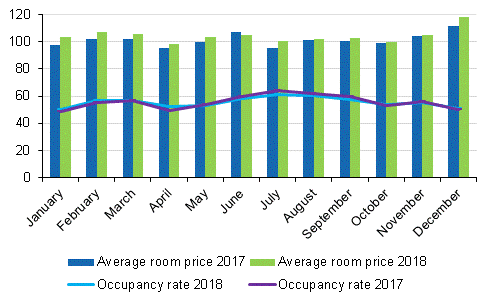
Regional development of overnight stays in 2018
In Mainland Finland, the growth in overnight stays was in 2018
biggest in Päijät-Häme, where 9.2 per cent more overnight stays
were recorded than in 2017. In South Ostrobothnia, overnight stays
went up by 6.3 per cent. Overnight stays in Central Finland and
Kainuu grew by around four per cent and in North Karelia, North
Ostrobothnia and Lapland by about three per cent. The capacity of
Päijät-Häme remained on level with the year 2017. The capacity of
accommodation establishments in South Ostrobothnia, Central
Finland, Kainuu and Lapland grew somewhat, while the capacity in
North Karelia and North Ostrobothnia went down slightly. In
addition, overnight stays in South Karelia increased by two per
cent and the number of overnight stays in Kanta-Häme grew by around
one per cent. Overnight stays in the regions of Satakunta and
Pirkanmaa remained almost on level with the previous year. In all
other regions, the numbers of overnight stays went down last year.
The biggest decreases in overnight stays were recorded in
Kymenlaakso, 5.8 per cent, and in Southwest Finland, 4.3 per cent.
Overnight stays in Central Ostrobothnia fell by 2.6 per cent and in
South Savo and Ostrobothnia by around two per cent in both. In
North Savo, one per cent fewer overnight stays were recorded than
in 2017.
In Åland, overnight stays decreased by 2.7 per cent from the year
before.
In absolute numbers, overnight stays in accommodation establishments increased most in Uusimaa, where good 97,000 more overnight stays were recorded, and in Lapland, where overnight stays grew by almost 87,000 from 2017.
The share of overnight stays by foreign visitors in all overnight stays was almost 47 per cent in the region of Uusimaa, and 52 per cent in Lapland. The share of overnight stays by non-resident tourists in South Karelia was around 33 per cent, in Ostrobothnia and South Savo 22 to 23 per cent. The shares were 19 to 21 per cent in Southwest Finland and Kymenlaakso. In North Ostrobothnia the share of overnight stays by non-resident tourists was 17 per cent. In Uusimaa, Russians barely managed to maintain their top position among all tourists. Accommodation establishments recorded around 269,000 overnight stays for them and good 247,000 for Germans. In Lapland, the biggest group of foreign visitors were British tourists for whom good 285,000 overnight stays were recorded. In North Ostrobothnia, South Karelia, South Savo and Kymenlaakso, Russians were the biggest group of foreign tourists while in Ostrobothnia and Southwest Finland, Swedes took the first position.
Change in overnight stays by region 2018/2017,%
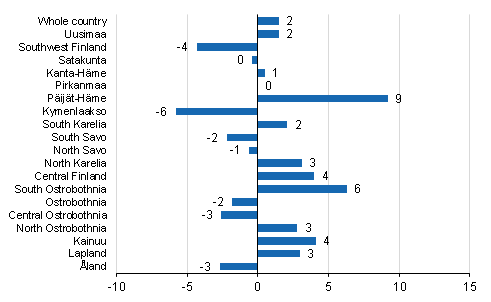
Growth in overnight stays by foreign visitors in Finland weaker than elsewhere in Europe in 2018
In 2018, overnight stays by foreign visitors recorded in Europe was 2.4 per cent higher than in the previous year, while a growth of only 1.5 per cent was attained for foreign visitors in Finland. In our neighbouring regions, the Nordic and Baltic countries, overnight stays by foreign visitors increased by 5.3 per cent, while the growth amounted to 4.7 per cent in Central Europe. Only in Southern Europe the growth in overnight stays of foreign visitors was weaker than in Finland, at 0.8 per cent. In the 2010s, overnight stays by foreign visitors in Europe have grown on average by around 4.9 per cent per year and in Finland on average by 4.0 per cent per year. In Finland, the development of overnight stays by foreigners was negative in 2014 to 2015.
Nights spent by non-residents in Europe (2004 = 100)
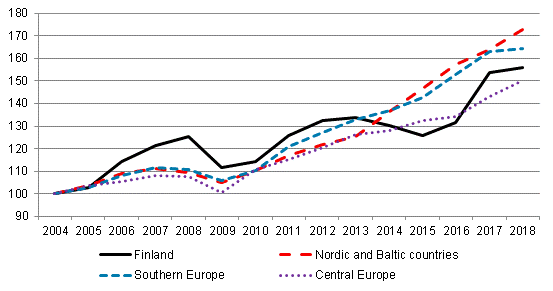
Growth in domestic overnight stays weak in Europe
Domestic overnight stays grew in Finland by 1.5 per cent and in Europe by 2.4 per cent in 2018. In our neighbouring regions of Nordic and Baltic countries, the growth in domestic overnight stays remained at 1.1 per cent. In Central Europe, domestic overnight stays grew by 3.0 per cent and in Southern Europe by 1.6 per cent. Over the 2010s, domestic overnight stays have grown in Europe yearly by an average of 2.6 per cent and in Finland by only one-half of this, 1.3 per cent.
The information on overnight stays in other European countries is based on monthly data on the use of capacity at European accommodation establishments collected by Eurostat.
Nights spent by residents in Europe (2004 = 100)
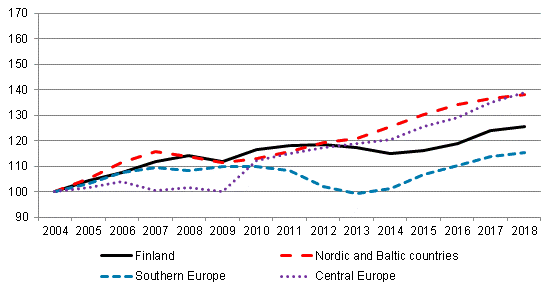
Number of accommodation establishments decreased but the room and bed capacity grew in 2018
In 2018, the number of accommodation establishments contained in the statistics went down by 11, but the room capacity increased by 837 rooms and the number of beds by 2,576 beds. The capacity grew in hotels and guest houses, while in camping sites, holiday villages and hostels the number of rooms and beds went down compared with 2017. Statistics Finland’s register of accommodation establishments has been updated with new and closed establishments and permanent changes in capacity in 2018.
In 2018, the statistics covered a total of 1,372 accommodation establishments: 675 hotels, 113 guest houses, 316 holiday villages, 219 camping sites and 49 hostels. Holiday villages of hotel calibre are included in hotels. The accommodation establishments had in total 69,671 rooms (or cottages) with a total of 172,668 beds. In addition to the room and bed capacity, the accommodation establishments had 19,886 caravan pitches with electricity connection, 15,299 of which were located at camping sites.
When the capacity of accommodation establishments is viewed according to the number of rooms, the statistics contained 985 establishments with fewer than 50 rooms and 387 establishments with at least 50 rooms in 2018. Measured by bed capacity, there were 906 establishments with fewer than one hundred beds and 466 establishments with at least one hundred beds.
In 2018, there were 1,103 accommodation establishments that were open year round and 269 establishments that were open part of the year; these were mostly camping sites and holiday villages.
Source: Accommodation Statistics. Statistics Finland
Inquiries: Marjut Tuominen 029 551 3556, Ossi Nurmi 029 551 2984, liikenne.matkailu@stat.fi
Director in charge: Mari Ylä-Jarkko
Publication in pdf-format (513.1 kB)
- Tables
-
Tables in databases
Pick the data you need into tables, view the data as graphs, or download the data for your use.
Appendix tables
- Appendix table 1. Capacity and its utilization in 2018 (9.4.2019)
- Appendix table 2. Nights spent in all establishments in 2018 (9.4.2019)
- Appendix table 3. Hotel capacity and capacity utilization in 2018 (9.4.2019)
- Appendix table 4. Nights spent in hotels in 2018 (9.4.2019)
- Appendix table 5. Visitor arrivals and nights spent by country of residence in 2018 (9.4.2019)
- Appendix table 6. Nights spent in all establishments by month in 2018 (9.4.2019)
- Appendix table 7.1. Nights spent by non-residents and annual change (%) in all establishments in 2018 (9.4.2019)
- Appendix table 7.2. Nights spent by non-residents and annual change (%) in all establishments in 2018 (9.4.2019)
- Appendix table 8.1. Nights spent by non-residents and annual change (%) in hotels in 2018 (9.4.2019)
- Appendix table 8.2. Nights spent by non-residents and annual change (%) in hotels in 2018 (9.4.2019)
- Appendix table 9.1. Capacity of accommodation establishments and capacity utilization by type of establishment in 2018 (9.4.2019)
- Appendix table 9.2. Capacity of accommodation establishments and capacity utilization by type of establishment, May-August 2018 (9.4.2019)
- Appendix table 10.1. Capacity of accommodation establishments by type of establishment in 2018 (9.4.2019)
- Appendix table 10.2. Capacity of accommodation establishments by opening season in 2018 (9.4.2019)
- Appendix table 10.3. Capacity of accommodation establishments by number of bed-places in 2018 (9.4.2019)
- Appendix table 10.4. Capacity of accommodation establishments by number of rooms in 2018 (9.4.2019)
Updated 9.4.2019
Official Statistics of Finland (OSF):
Accommodation statistics [e-publication].
ISSN=1799-6325. 2018. Helsinki: Statistics Finland [referred: 29.12.2025].
Access method: http://stat.fi/til/matk/2018/matk_2018_2019-04-09_tie_001_en.html

